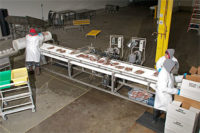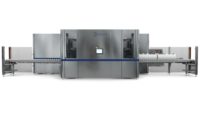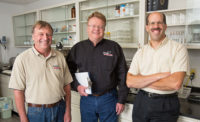Food Safety
HPP puts on a full-court press
High-pressure pasteurization (HPP) continues to gain strength as a food-safety defense strategy.

More meat and poultry processors are turning to high-pressure pasteurization (HPP). It’s no wonder with the advantages of the technology mounting, which includes a unique set of benefits to consumers and processors alike. For example, HPP offers food-safety benefits, increased shelf life and improved organoleptic benefits.
“HPP delivers these benefits without negatively impacting the flavor profile compared to chemical pathogen inhibitors and other pasteurization processes,” says Mark Fleck, HPP market development manager at Universal Pasteurization Co., in Lincoln, Neb.
From an increased food-safety perspective, HPP addresses the most common food pathogen concerns: E. coli O157:H7, Salmonella, Listeria monocytogenes, Campylobacter and Vibrio spp. in seafood.
In addition to the advantages of increased food safety, another huge benefit to processors and consumers is the ability to increase shelf life without adding ingredients to the product.
“The producer is able to take a product that traditionally had a very short shelf life and greatly increase the number of days,” says Greg Cooper, plant manager at Cooper Farms’ Van Wert, Ohio, cooked-meats processing facility. “This also gives the product a cleaner taste.”
Shelf life is increased because HPP has an impact on the product spoilage organisms, such as molds, yeasts and bacteria that cause spoilage.
“It is common to realize a two times or more increase in product shelf life without the use of bacteriocins and chemical preservatives,” Fleck says. “The added shelf life allows the processors to reduce production changeovers, ship full truckloads and reach a larger geographical market — all potentially benefitting their bottom line.”
The HPP process takes the pressure within the vessel to an extremely high pounds-per-square-inch. In many cases, this is above 80,000 psi, Cooper explains.
“When this happens, the product is squeezed equally in all directions,” he says. “Products that are gas-flushed or packed in flexible film can [undergo] HPP without compromising the seals and creating leaks.”
When the product is squeezed at these high pressures, any foodborne pathogens or spoilage organisms within the package are killed, which in turn improves food safety and increases shelf life.
By eliminating the foodborne pathogens in the product, a processor doesn’t need to add ingredients to the product for pathogen reduction.
“When these ingredients are added to products, they also have to be listed on the ingredient label,” Cooper says. “If the ingredient is not in the product, it doesn’t have to be on the label, hence a cleaner label.”
In turn, the industry is seeing a growing market trend for clean-label products.
“More and more retailers are dedicating valuable shelf space for clean-label products to meet an increasing consumer demand,” Fleck says. “HPP has the added benefit of destroying vegetative bacteria whereas many chemical preservatives simply inhibit bacteria growth.”
HPP advances
HPP equipment manufacturers continue raising the bar by offering larger capacity systems. For larger product runs, these new HPP systems drive down cost per unit of products that undergo HPP, says Jeff Barnard, president at Universal Pasteurization.
HPP is not without its challenges to processors, though. For example, one difficulty with the HPP process is maintaining the system.
“Dealing with such great pressures, parts can wear out very quickly,” Cooper explains. “So it is important that the system is monitored very closely, and when an issue occurs, it is dealt with quickly. And since the parts are designed to hold up to the extreme pressure, they are very costly to replace.”
HPP equipment manufacturers are improving reliability and uptime of the HPP systems, which helps contain the cost of operating these multimillion-dollar machines, Barnard adds.
Barnard sees one of the greatest challenges to HPP technology as being a batch process.
“Many production facilities have difficulty integrating a batch process into their current inline operations,” he says.
Finding space in tight production facilities is another challenge. “One has to consider space required for the HPP systems, for product staging and equipment maintenance,” Barnard says.
Companies that provide HPP outsourcing services, such as Universal Pasteurization, are coming in to the market to address some of these issues.
“Outsourcers typically operate two to six HPP systems per location, serving the needs of numerous producers in the area,” Barnard says.
Adding to the growth of HPP’s use, processors are reintroducing raw materials and ingredients after HPP. For example, processors use HPP to address microbial concerns of one raw material in a finished product, Fleck explains. The raw material is then reintroduced back at the processor where good manufacturing practices are used to produce the finished product.
“This smart approach gets at the root cause of the food-safety concern and saves money for the processor,” Fleck says.
In recent years, the food industry has witnessed HPP growth rates of 20 percent to 25 percent per year, he adds. In addition to ready-to-eat and ready-to-cook proteins, HPP technology is applicable to many other food and beverage categories, including premium juices, guacamole, salsa, dips and salad dressings.
“We see interest in HPP accelerating, not slowing down,” Fleck says.
Looking for a reprint of this article?
From high-res PDFs to custom plaques, order your copy today!










